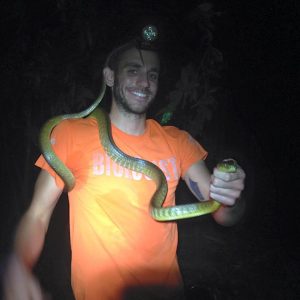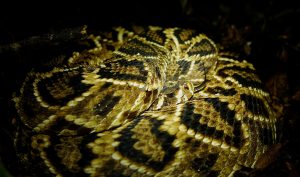**The AGA grants EECG Research Awards each year to graduate and post-doctoral researchers who are at a critical point in their research, where additional funds would allow them to conclude their research project and prepare it for publication. EECG awardees also get the opportunity to hone their science communication and write three posts over their grant tenure for the AGA Blog. In the first in the series, our EECG awardees write about their research and their interests as an ’embarkation’.
 About the Author: Mike (he/him) is a PhD candidate at Florida State University working in the lab of Dr. Darin Rokyta. He is broadly interested in understanding how natural selection shapes predatory traits at the molecular level. While his background enphasizes field work and organismal research, his current focus is deciphering complex traits using genomics, transcriptomics, and other sequence-based bioinformatic strategies. He was awarded the EECG in 2021 for his work characterizing sensory phenotypes and investigating the coevolution of venom and sensory perception in rattlesnakes. Follow Mike on twitter @Mike_Hogan_.
About the Author: Mike (he/him) is a PhD candidate at Florida State University working in the lab of Dr. Darin Rokyta. He is broadly interested in understanding how natural selection shapes predatory traits at the molecular level. While his background enphasizes field work and organismal research, his current focus is deciphering complex traits using genomics, transcriptomics, and other sequence-based bioinformatic strategies. He was awarded the EECG in 2021 for his work characterizing sensory phenotypes and investigating the coevolution of venom and sensory perception in rattlesnakes. Follow Mike on twitter @Mike_Hogan_.
Typically, the first term associated with rattlesnakes is venom. True, their venom represents a crucial aspect of their biology, however the complete ecological context in which venom is deployed is far more complex and fascinating. Long before a rattlesnake can use its venom and enjoy the resulting meal, it must first detect, track down, and ultimately sense the presence of a potential prey item. Prey-based selective pressures should drive the evolution of genes responsible for prey detection and acquisition, resulting in signals of adaptive evolution in sensory genes comparable to venom genes.

Rattlesnakes sense the world by incorporating diverse stimuli through the integration of trichromatic color vision, bifocal heat-sensing, and dual-system chemoperception. The genetic underpinnings are well characterized for pitviper vision (Katti et al. 2018) and heat-sensing (Gracheva et al. 2010; Tu et al. 2020)while a similar characterization of their chemosensory abilities has been lacking… that is, until recently. My PhD project has attempted to fill this gap through meticulous gene annotation and biological interpretation using state of the art bioinformatic approaches. I am pleased to announce a recent publication reporting my findings characterizing the complete chemosensory repertoire of the eastern diamondback rattlesnake (Hogan et al. 2021), which was published online earlier this month.

To summarize, we found hundreds of olfactory and vomeronasal receptors underlying the chemosensory phenotype in rattlesnakes. While this is an important finding, it is also problematic from an evolutionary biologist’s perspective: How can we ever know which receptor genes are used for what functions, and what factors are driving their evolution? It is well known that vertebrates utilize chemoperception for a multitude of adaptive behaviors including mate detection, parental care, and navigation. This is all true of rattlesnakes, so why even bother researching a venomous snake? What a hassle!
Venom and its underlying genetics have revealed considerable detail about the evolution of snakes. For instance, we know that homologous venom secreting structures and forked-tongue chemosensory systems occurred long before snakes branched off from lizards (Fry et al. 2009) during the Jurassic. We also have strong evidence that venom toxicity as a phenotype is driven by prey specificity, where geographic variation in venom composition corresponds with evolved resistance in prey at the population level (Margres et al. 2017) — a prime example of “evolutionary arms race”. This raises the question: can specialized venom-toxicity evolve without specialized prey-sensing?This is my focal research question. Hypothesis = no, it can’t. Null = yes, it can.
With the support of the EECG research award, I will be using RNA-seq and gene expression analysis to categorize the hundreds of chemosensory genes identified for rattlesnakes. We will tease out chemosensory genes evolving functions for mate detection, environmental cues, and prey perception. By utilizing non-model systems, we hope to answer outstanding questions regarding basic evolutionary concepts.
References



